Home
/Hydrotherapy
Hydrotherapy
Greyfriars has a hydrotherapy pool and water treadmill – which allows us the flexibility to choose the most suitable hydrotherapy treatment for our patients. The hydrotherapy team is overseen by our Certified Canine Rehabilitation Practitioners and ACPAT Chartered Physiotherapists.
The hydrotherapy pool is a large
5 metre by 10 metre heated swimming pool, complete with swim jets and resting/ rehabilitation platforms.

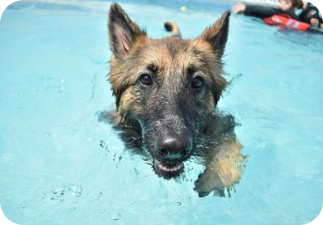
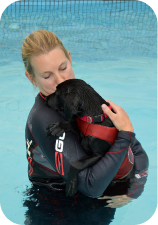
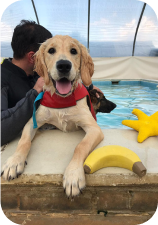
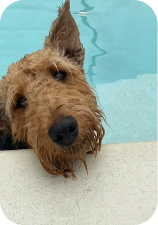

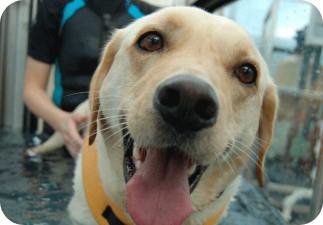
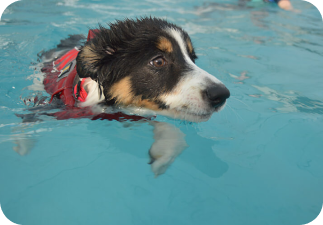
Hydrotherapy at Greyfriars
Our initial treatment choice will be based on our clinical knowledge and experience and be influenced by your pet’s general health, surgical treatment or injury. We also take into account the breed, size and behaviour of your dog or cat and adjust hydrotherapy treatments accordingly. For some conditions, such as hip dysplasia, we find a combination of pool and water treadmill can give very successful results.
The hydrotherapy team are Registered Canine Hydrotherapists (RCH) with the National Association of Registered Canine Hydrotherapists (NARCH). This means we work to the highest ethical and care standards in the UK and you can be sure that the member of staff looking after your pet is well trained, qualified and experienced.
As well as hydrotherapy for rehabilitation we also offer fitness swims and learn to swim sessions.
Hydrotherapy pool
10 x 5 metres – one of the largest in the UK
A larger pool size allows for more relaxed natural behaviour and motivation
Allows early rehabilitation where reduced weight bearing or load on joints is important – post surgery or injury
Resting and treatment platforms allow physiotherapy treatment and massage in the warm water in the pool
Heated to 29-30 degrees C – relaxing and pain relieving
Swim jets – for neurological input or to increase effort, build muscle and improve cardiovascular fitness
Water treadmill
Allows early rehabilitation for spinal injury/surgery patients
Observation and filming from all sides for gait assessment
Hydrotherapists can be hands on to aid correct gait
Water height can be adjusted to decrease/increase weight bearing
Water height can be adjusted to achieve movements we require
Speed and duration can be adjusted to achieve optimal gait
Useful for dogs that are nervous about water or swimming
Hydrotherapy can be used to
Decrease pain
Increase sensory perception
Relax muscle tension or spasm
Reduce oedema (swelling)
Increase muscle bulk, strength and tone
Improve muscle patterning and recruitment – extremely important for spinal injury dogs learning to walk again
Prevent secondary complications as a result of limb disuse, muscle contracture, gait abnormalities
Help with earlier return to normal life or work – important for assistance or police dogs
Increase joint range of movement
Slow the progression of the effects of degenerative disease – including osteoarthritis and degenerative myelopathy
Improve quality of life – especially for older or disabled dogs
Meet our Hydrotherapy team
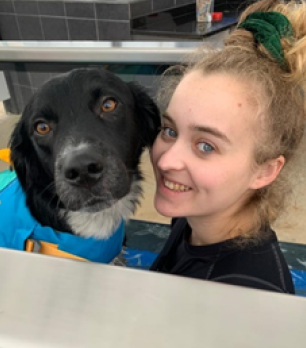
Becca Golton (RCH)

Kerry Mitchell (RCH)
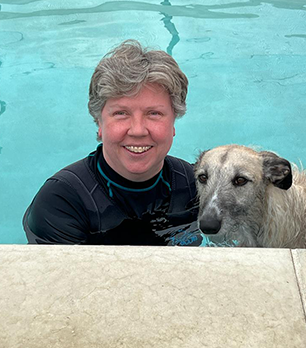
Kirsten Foulkes (RCH)
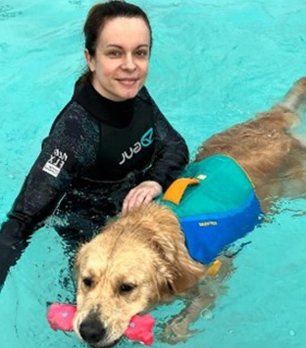
Leanne Drayton
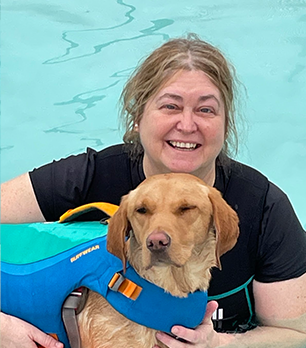
Penny Potterton
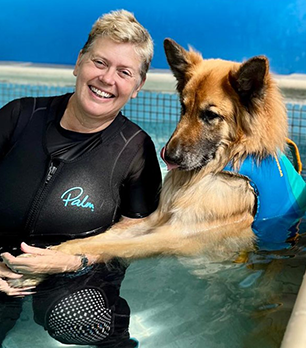
Angela Griffiths (CCRP, RCH)
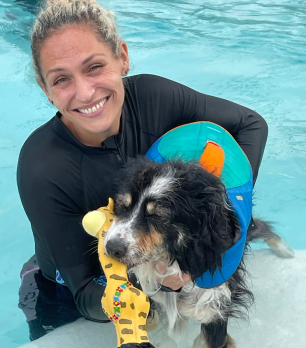
Kate Parsons (Vet Physio, RCH)

Becky Blanchard (RCH)
Contact us:
For enquiries regarding treatment for your pet contact:
reception@greyfriarsrehab.co.uk
Mobile: 07840 825316
Landline: 01483 811172
Please leave a clear message if the call goes to answerphone or send us an email and we will get back to you as soon as we are able. When we are busy with clients we may be unable to answer immediately.
For all training enquiries email: training@greyfriarsrehab.co.uk
Address:
Greyfriars Veterinary Rehabilitation and Hydrotherapy Referrals
The Veterinary Centre
Hogs Back
Guildford
Surrey
GU3 1AG
HOW TO FIND US :
Our postcode is shared by several local properties and SatNav will direct you to the wrong address! Once you are in our area follow the directions below.
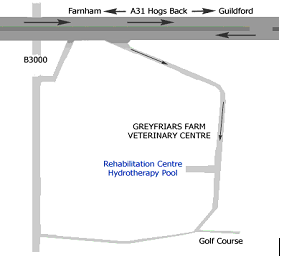
From M25 London Orbital – exit the motorway at junction 10 and follow the A3 south towards Guildford. Stay on the A3 past all the Guildford exits. The road rises uphill as you leave Guildford’s outskirts – get into left hand lane. At the brow of the hill (where a bridge crosses) is the exit to the A31 towards Farnham. You are now on a slip road that joins the A31 dual carriageway. Now follow directions from Guildford
From Guildford – Join the A31 (dual carriageway) towards Farnham. You will shortly see a sign for Greyfriars House – DO NOT TAKE THIS TURNING! Beyond the Greyfriars House turning you will see a verge side sign for a Veterinary Centre.
Move into the left hand lane and slow down. 250m further is the entrance to the Veterinary Centre and the Vineyard. Follow the track down – drive slowly – there are speed bumps and the track is single lane with passing places. Drive past the Vineyard office and the Equine Centre. The pool and physiotherapy centre is on the left hand side. There is some parking for clients there with dedicated parking for disabled clients/dogs (clearly signposted) If these car parks are full, drive a few yards further down the track and turn left into our lower car park.
From the M3 – exit the motorway at junction 4 and take the A331 link road towards Farnham and at the final roundabout turn left onto the slip road that takes you onto the A31. Then follow directions as if from Farnham
From Farnham – Take the A31 towards Guildford. At the end of the dual carriageway section the road splits to Guildford town centre and the A3 towards London. Get into right hand lane signposted A 31 Farnham which allows you to return on the opposite carriageway. Then follow directions as from Guildford
If you miss our turning! – take the next exit 150m past us signposted B3000 towards Puttenham. Turn left at the bottom of the slip road and go down the hill. On the right is a Harvester Inn. Opposite is a rough track past the golf club which rises uphill. Keep on the track bearing left and you will arrive at our Centre with the lower car park on your right and the hydrotherapy pool on the left. DRIVE SLOWLY – THE TRACK IS UNEVEN, SINGLE LANE WITH PASSING PLACES AND YOU MAY MEET OTHER VEHICLES OR PEOPLE WALKING WITH DOGS.
What3Words location – https://w3w.co/canines.stamp.soones